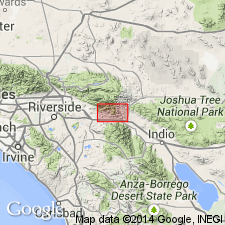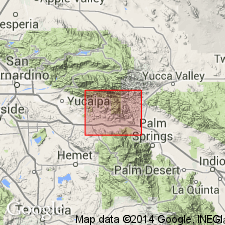
- Usage in publication:
-
- Burnt Canyon breccia
- Modifications:
-
- Areal extent
- AAPG geologic province:
-
- Salton basin
Summary:
Map sheet 20. Burnt Canyon breccia. Shown on map legend as a landslide deposit. Age is Quaternary.
[Report covers San Andreas fault zone in San Gorgonio Pass, Riverside Co., southern CA.]
Source: GNU records (USGS DDS-6; Menlo GNULEX).

- Usage in publication:
-
- Burnt Canyon breccia
- Modifications:
-
- Areal extent
- Dominant lithology:
-
- Conglomerate
- AAPG geologic province:
-
- Salton basin
Summary:
Pg. 325 (table 1), 352, pls. 1, 3. Burnt Canyon breccia. Described in San Gorgonio Pass area as a dissected landslide deposit. Maximum thickness about 100 feet. Rests partly on crystalline complex and partly on Heights fanglomerate. Age is Quaternary.
[Report covers San Andreas fault zone in San Gorgonio Pass, Riverside Co., southern CA.]
Source: US geologic names lexicon (USGS Bull. 1200, p. 546).
For more information, please contact Nancy Stamm, Geologic Names Committee Secretary.
Asterisk (*) indicates published by U.S. Geological Survey authors.
"No current usage" (†) implies that a name has been abandoned or has fallen into disuse. Former usage and, if known, replacement name given in parentheses ( ).
Slash (/) indicates name conflicts with nomenclatural guidelines (CSN, 1933; ACSN, 1961, 1970; NACSN, 1983, 2005, 2021). May be explained within brackets ([ ]).

